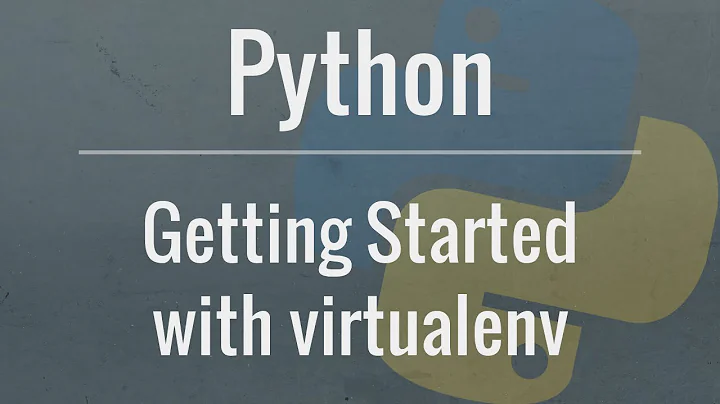What is the relationship between virtualenv and pyenv?
Solution 1
Pyenv and virtualenv are very different tools that work in different ways to do different things:
Pyenv is a bash extension - will not work on Windows - that intercepts your calls to python, pip, etc., to direct them to one of several of the system python tool-chains. So you always have all the libraries that you have installed in the selected python version available - as such it is good for users who have to switch between different versions of python.
VirtualEnv, is pure python so works everywhere, it makes a copy of, optionally a specific version of, python and pip local to the activate environment which may or may not include links to the current system tool-chain, if it does not you can install just a known subset of libraries into that environment. As such it is almost certainly much better for testing and deployment as you know exactly which libraries, at which versions, are used and a global change will not impact your module.
venv python > 3.3
Note that from Python 3.3 onward there is a built in implementation of VirtualEnv called venv (with, on some installations a wrapper called pyvenv - this wrapper is deprecated in Python 3.6), which should probably be used in preference. To avoid possible issues with the wrapper it is often a good idea to use it directly by using /path/to/python3 -m venv desired/env/path or you can use the excellent py python selector on windows with py -3 -m venv desired/env/path. It will create the directory specified with desired/env/path configure and populate it appropriately. In general it is very much like using VirtualEnv.
Additional Tools
There are a number of tools that it is worth mentioning, and considering, as they can help with the use of one or more of the above:
- VirtualEnvWrapper Manage and simplify the use and management of VirtualEnv - Cross Platform.
- pyenv-virtualenv, installed by pyenv-installer, which gives PyEnv tools for managing and interfacing to VirtualEnv - with this you can have a base installation that includes more than one version of python and create isolated environments within each of them - Linux/OS-X. Suggested by Johann Visagie
- PyInstaller can take your python code, possibly developed & tested under VirtualEnv, and bundle it up so that it can run one platforms that do not have your version of python installed - Note that it is not a cross compiler you will need a Windows (virtual-)machine to build Windows installs, etc., but it can be handy even where you can be sure that python will be installed but cannot be sure that the version of python and all the libraries will be compatible with your code.
Solution 2
Short version:
-
virtualenvallows you to create local (per-directory), independent python installations by cloning from existing ones -
pyenvallows you to install (build from source) different versions of Python alongside each other; you can then clone them with virtualenv or use pyenv to select which one to run at any given time
Longer version:
Virtualenv allows you to create a custom Python installation e.g. in a subdirectory of your project. This is done by cloning from an existing Python installation somewhere on your system (some files are copied, some are reused/shared to save space). Each of your projects can thus have their own python (or even several) under their respective virtualenv. It is perfectly fine for some/all virtualenvs to even have the same version of python (e.g. 3.8.5) without conflict - they live separately and don't know about each other. If you want to use any of those pythons from shell, you have to activate it (by running a script which will temporarily modify your PATH to ensure that that virtualenv's bin/ directory comes first). From that point, calling python (or pip etc.) will invoke that virtualenv's version until you deactivate it (which restores the PATH). It is also possible to call into a virtualenv Python using its absolute path - this can be useful e.g. when invoking Python from a script.
Pyenv operates on a wider scale than virtualenv. It is used to install (build from source) arbitrary versions of Python (it holds a register of available versions). By default, they're all installed alongside each other under ~/.pyenv, so they're "more global" than virtualenv. Then, it allows you to configure which version of Python to run when you use the python command (without virtualenv). This can be done at a global level or, separately, per directory (by placing a .python-version file in a directory). It's done by prepending pyenv's shim python script to your PATH (permanently, unlike in virtualenv) which then decides which "real" python to invoke. You can even configure pyenv to call into one of your virtualenv pythons (by using the pyenv-virtualenv plugin). You can also duplicate Python versions (by giving them different names) and let them diverge.
Using pyenv can be a convenient way of installing Python for subsequent virtualenv use.
Related videos on Youtube
truth1ness
Updated on January 05, 2021Comments
-
truth1ness over 3 years
I recently learned how to use virtualenv and virtualenvwrapper in my workflow but I've seen pyenv mentioned in a few guides but I can't seem to get an understanding of what pyenv is and how it is different/similar to virtualenv. Is pyenv a better/newer replacement for virtualenv or a complimentary tool? If the latter what does it do differently and how do the two (and virtualenvwrapper if applicable) work together?
-
Martijn Pieters almost 9 yearsfgimian.github.io/blog/2014/04/20/…: However, there is another alternative called pyenv which has several significant advantages.
-
User over 7 years
-
-
wjv about 8 yearsIt probably worth mentioning pyenv-virtualenv, a pyenv plugin that allows pyenv and virtualenv to work seamlessly in unison. If you’ve installed pyenv using pyenv-installer, pyenv-virtualenv will already be present. * github.com/yyuu/pyenv-virtualenv * github.com/yyuu/pyenv-installer
-
Flimm over 7 yearsWhat about
venv, now in the standard library? -
 Steve Barnes over 7 years@Flimm: From python 3.3 onward venv is a part of the standard library and should be used instead of virtualenv as it is often described as "virtualenv done right" - reddit.com/r/learnpython/comments/4hsudz/pyvenv_vs_virtualenv
Steve Barnes over 7 years@Flimm: From python 3.3 onward venv is a part of the standard library and should be used instead of virtualenv as it is often described as "virtualenv done right" - reddit.com/r/learnpython/comments/4hsudz/pyvenv_vs_virtualenv -
 Turn over 7 yearspyenv-virtualenv is not (or at least is no longer) linux only. There is a homebrew package for it for an easy install on MacOS.
Turn over 7 yearspyenv-virtualenv is not (or at least is no longer) linux only. There is a homebrew package for it for an easy install on MacOS. -
Kiran Kumar Kotari over 4 yearsIn recent days we developed pyenv for windows called pyenv-win. Have a look if it helps





